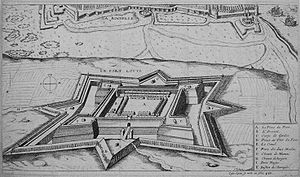
Battle of Blavet
Encyclopedia
The Battle of Blavet was an encounter between the Huguenot
forces of Soubise
and a French fleet under the Duke of Nevers
in Blavet harbour (Port de Blavet, modern Port-Louis
), Brittany
in January 1625, triggering the Second Huguenot rebellion against the Crown of France.
 An important Huguenot rebellion against the pro-Catholic King of France Louis XIII had taken place a few years before, in 1621-1622, ending in stalemate and in the sealing of the Treaty of Montpellier
An important Huguenot rebellion against the pro-Catholic King of France Louis XIII had taken place a few years before, in 1621-1622, ending in stalemate and in the sealing of the Treaty of Montpellier
.
Resentment was breeding on the Huguenot side however as king Louis XIII was not respecting the clauses of the Treaty of Montpellier. Not a single condition is said to have been respected, as Toiras was reinforcing the fortification of Fort Louis
, instead of dismantling it, right under the walls of the Huguenot stronghold of La Rochelle
, and as a strong fleet was being prepared in Blavet for the eventuality of a siege of the city. The threat of a future siege on the city of La Rochelle was obvious, both to Soubise
and the people of La Rochelle.
At the same time the Huguenots and Soubise were very defiant of the Crown, displaying intentions to become independent on the model of the Dutch Republic
: "If the citizens, abandoned to their guidance, were threateneed in their rights and creeds, they would imitate the Dutch
in their resistance to Spain, and defy all the power of the monarchy to reduce them." (Mercure de France
)
 A fleet of five warships was being prepared at Blavet, for a future blockade of the city of La Rochelle. Emissaries were sent to Paris to obtain the execution of the Treaty of Montpellier, but in vain.
A fleet of five warships was being prepared at Blavet, for a future blockade of the city of La Rochelle. Emissaries were sent to Paris to obtain the execution of the Treaty of Montpellier, but in vain.
Soubise resolved to take action. With a few ships which he had prepared at Chef de Baye, near La Rochelle
, he set sail, and attacked Blavet in January 1625. He had 12 small boats, 300 well-armed soldiers and 100 sailors. Six Royal great royal ships were at anchor, "all well armed with cannon, but lacking men and ammunition".
Soubise captured the fleet by surprise, and became master of the city, especially taking possession of La Vierge, the largest known warship of the period: it weighed 500 tons, had 80 bronze cannons, and had cost 200,000 crowns to build.
The Duke of Vendôme, Commander of the Province, attempted to block Soubise in the harbour, with heavy chain and batteries. After two weeks however, Soubise managed to break through with his fleet.
Soubise, now in possession of a formidable fleet of 70 ships, then anchored in front of Ile de Ré
, which he had occupied with his troops.
These events led to a strong reaction from the King, who set up a counter-attack in September 1625, leading to the Capture of Ile de Ré, and with Soubise fleeing to England. Soubise would return two years later with a large fleet under the Duke of Buckingham
, leading to the final showdown of the Siege of La Rochelle
(1627–1628).
Huguenot
The Huguenots were members of the Protestant Reformed Church of France during the 16th and 17th centuries. Since the 17th century, people who formerly would have been called Huguenots have instead simply been called French Protestants, a title suggested by their German co-religionists, the...
forces of Soubise
Soubise
Soubise can refer to:* Soubise sauce, a béchamel-based sauce containing strained or puréed onions* Soubise, a commune of the Charente-Maritime département, in France* Benjamin de Rohan, duc de Soubise , Huguenot leader...
and a French fleet under the Duke of Nevers
Charles I, Duke of Mantua
Charles Gonzaga was Duke of Mantua and Duke of Montferrat from 1627 until his death. He was also Duke of Rethel and Nevers, as well as Prince of Arches.-Biography:...
in Blavet harbour (Port de Blavet, modern Port-Louis
Port-Louis, Morbihan
Port-Louis is a commune in the Morbihan department of Brittany in north-western France.-Demographics:Inhabitants of Port-Louis are called in French Port-Louisiens.-References:* * -External links:* * *...
), Brittany
Brittany
Brittany is a cultural and administrative region in the north-west of France. Previously a kingdom and then a duchy, Brittany was united to the Kingdom of France in 1532 as a province. Brittany has also been referred to as Less, Lesser or Little Britain...
in January 1625, triggering the Second Huguenot rebellion against the Crown of France.
Background

Treaty of Montpellier
The Treaty of Montpellier was signed in Montpellier on October 18, 1622 between King Louis XIII of France and Duke Henry II of Rohan. The treaty followed the Siege of Montpellier and ended hostilities between French royalists and the Huguenots...
.
Resentment was breeding on the Huguenot side however as king Louis XIII was not respecting the clauses of the Treaty of Montpellier. Not a single condition is said to have been respected, as Toiras was reinforcing the fortification of Fort Louis
Fort Louis (La Rochelle)
Fort Louis was a Royal fort built just outside the walls of the Huguenot city in La Rochelle.The fort was a source of great tension between the Huguenots of La Rochelle and Louis XIII, and was perceived as a real threat to their survival...
, instead of dismantling it, right under the walls of the Huguenot stronghold of La Rochelle
La Rochelle
La Rochelle is a city in western France and a seaport on the Bay of Biscay, a part of the Atlantic Ocean. It is the capital of the Charente-Maritime department.The city is connected to the Île de Ré by a bridge completed on 19 May 1988...
, and as a strong fleet was being prepared in Blavet for the eventuality of a siege of the city. The threat of a future siege on the city of La Rochelle was obvious, both to Soubise
Soubise
Soubise can refer to:* Soubise sauce, a béchamel-based sauce containing strained or puréed onions* Soubise, a commune of the Charente-Maritime département, in France* Benjamin de Rohan, duc de Soubise , Huguenot leader...
and the people of La Rochelle.
At the same time the Huguenots and Soubise were very defiant of the Crown, displaying intentions to become independent on the model of the Dutch Republic
Dutch Republic
The Dutch Republic — officially known as the Republic of the Seven United Netherlands , the Republic of the United Netherlands, or the Republic of the Seven United Provinces — was a republic in Europe existing from 1581 to 1795, preceding the Batavian Republic and ultimately...
: "If the citizens, abandoned to their guidance, were threateneed in their rights and creeds, they would imitate the Dutch
Netherlands
The Netherlands is a constituent country of the Kingdom of the Netherlands, located mainly in North-West Europe and with several islands in the Caribbean. Mainland Netherlands borders the North Sea to the north and west, Belgium to the south, and Germany to the east, and shares maritime borders...
in their resistance to Spain, and defy all the power of the monarchy to reduce them." (Mercure de France
Mercure de France
The Mercure de France was originally a French gazette and literary magazine first published in the 17th century, but after several incarnations has evolved as a publisher, and is now part of the Éditions Gallimard publishing group....
)
Battle of Blavet

Soubise resolved to take action. With a few ships which he had prepared at Chef de Baye, near La Rochelle
La Rochelle
La Rochelle is a city in western France and a seaport on the Bay of Biscay, a part of the Atlantic Ocean. It is the capital of the Charente-Maritime department.The city is connected to the Île de Ré by a bridge completed on 19 May 1988...
, he set sail, and attacked Blavet in January 1625. He had 12 small boats, 300 well-armed soldiers and 100 sailors. Six Royal great royal ships were at anchor, "all well armed with cannon, but lacking men and ammunition".
Soubise captured the fleet by surprise, and became master of the city, especially taking possession of La Vierge, the largest known warship of the period: it weighed 500 tons, had 80 bronze cannons, and had cost 200,000 crowns to build.
The Duke of Vendôme, Commander of the Province, attempted to block Soubise in the harbour, with heavy chain and batteries. After two weeks however, Soubise managed to break through with his fleet.
Soubise, now in possession of a formidable fleet of 70 ships, then anchored in front of Ile de Ré
Île de Ré
Île de Ré is an island off the west coast of France near La Rochelle, on the northern side of the Pertuis d'Antioche strait....
, which he had occupied with his troops.
These events led to a strong reaction from the King, who set up a counter-attack in September 1625, leading to the Capture of Ile de Ré, and with Soubise fleeing to England. Soubise would return two years later with a large fleet under the Duke of Buckingham
Duke of Buckingham
The titles Marquess and Duke of Buckingham, referring to Buckingham, have been created several times in the peerages of England, Great Britain, and the United Kingdom. There have also been Earls of Buckingham.-1444 creation:...
, leading to the final showdown of the Siege of La Rochelle
Siege of La Rochelle
The Siege of La Rochelle was a result of a war between the French royal forces of Louis XIII of France and the Huguenots of La Rochelle in 1627-1628...
(1627–1628).

